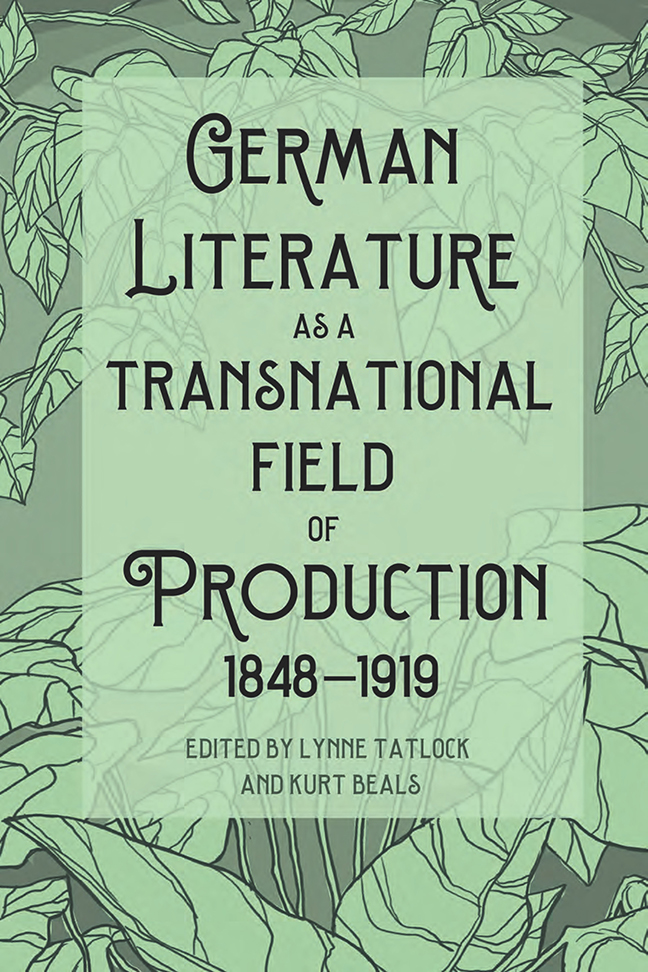Book contents
- Frontmatter
- Contents
- Acknowledgments
- Introduction: A Transnational Literary Field in the Age of Nationalism
- 1 The Passion of Johannes Scherr: Historiography as Trauma
- 2 Between Integration and Differentiation: On the Relationship between German and Austrian Literature in the Second Half of the Nineteenth Century
- 3 Reading Stifter in America
- 4 Travel Writing and Transnational Marketing: How Ida Pfeiffer brought the World to Austria and Beyond
- 5 Ernst Brausewetter's Meisternovellen Deutscher Frauen (1897–98): Gender, Genre, and (Inter)National Aspiration
- 6 Arbiter of Nation? The Strange Case of Hans Müller-Casenov's The Humour of Germany (1892/1893)
- 7 Visualizing the End: Nation, Empire, and Neo-Roman Mimesis in Keller and Fontane
- 8 Eurocentric Cosmopolitanism in Thomas Mann's Buddenbrooks
- 9 European Peace from a Transatlantic Perspective: Victor Hugo and Bertha von Suttner
- 10 Hermann Graf Keyserling and Gu Hongming’s Ethics of World Culture: Confucianism, Monarchism, and Anti-Colonialism
- 11 Constructing Symphonic Worlds: Gustav Mahler, Weltliteratur, and the Musical Program
- 12 The Garb of National Literature: Transnational Identities and the Early Twentieth-Century Schriftstreit
- 13 From European Symbolism to German Gesture: The International and Transnational Nationalism of Stefan George's Blätter für die Kunst
- 14 Canon Fire: Dada's Attack on National Literature
- Selected Bibliography
- Contributors
- Index
12 - The Garb of National Literature: Transnational Identities and the Early Twentieth-Century Schriftstreit
Published online by Cambridge University Press: 10 January 2024
- Frontmatter
- Contents
- Acknowledgments
- Introduction: A Transnational Literary Field in the Age of Nationalism
- 1 The Passion of Johannes Scherr: Historiography as Trauma
- 2 Between Integration and Differentiation: On the Relationship between German and Austrian Literature in the Second Half of the Nineteenth Century
- 3 Reading Stifter in America
- 4 Travel Writing and Transnational Marketing: How Ida Pfeiffer brought the World to Austria and Beyond
- 5 Ernst Brausewetter's Meisternovellen Deutscher Frauen (1897–98): Gender, Genre, and (Inter)National Aspiration
- 6 Arbiter of Nation? The Strange Case of Hans Müller-Casenov's The Humour of Germany (1892/1893)
- 7 Visualizing the End: Nation, Empire, and Neo-Roman Mimesis in Keller and Fontane
- 8 Eurocentric Cosmopolitanism in Thomas Mann's Buddenbrooks
- 9 European Peace from a Transatlantic Perspective: Victor Hugo and Bertha von Suttner
- 10 Hermann Graf Keyserling and Gu Hongming’s Ethics of World Culture: Confucianism, Monarchism, and Anti-Colonialism
- 11 Constructing Symphonic Worlds: Gustav Mahler, Weltliteratur, and the Musical Program
- 12 The Garb of National Literature: Transnational Identities and the Early Twentieth-Century Schriftstreit
- 13 From European Symbolism to German Gesture: The International and Transnational Nationalism of Stefan George's Blätter für die Kunst
- 14 Canon Fire: Dada's Attack on National Literature
- Selected Bibliography
- Contributors
- Index
Summary
On July 2, 1909, a number of the leading figures in the German book trade met in Leipzig to draw up the articles of incorporation for a new publishing house to be called “Der Tempel. Bund deutscher Verleger GmbH.” The partners in this endeavor were Samuel Fischer (of S. Fischer Verlag in Berlin), Eugen Diederichs (of Eugen Diederichs Verlag in Jena), Julius Zeitler (of Verlag Julius Zeitler in Leipzig), and Hans von Weber (of Hyperion Verlag in Munich), along with Carl Ernst Poeschel, a Leipzig-based printer and publisher, and Georg Hartmann, the owner of a type foundry in Frankfurt am Main.
The six men had assembled to solve an urgent problem then afflicting the German book trade, namely a surplus of collected works editions of literary classics, the so-called Klassikerausgaben. The copyright on most of the authors from the golden age of German literature (the Goethezeit, stretching from 1770–1830) had expired in 1871, precipitating a flood of reprints. No fewer than seventeen collected works editions of Goethe were published between 1871 and 1900, for example, which created an ever more segmented market with ever diminishing returns for the book industry. The Tempel-Verlag was founded to consolidate this market by channeling the financial capital of multiple publishing houses into the production of just one set of new titles. It was, as Hans von Weber quipped, a “Vereinigung zur Verhinderung von Klassikerausgaben” (Association for the Prevention of Collected Works Editions).
To differentiate their product from existing titles, the founders of the Tempel-Verlag decided to emphasize the graphic design of their books, drawing special attention to their use of a new font that had been commissioned specifically for the occasion. A 1909 press release proudly announces: “die Ausgaben werden in einer besonders und ausschließlich dafür bestimmten Fraktur von E. R. Weiß, dem ausgezeichneten Buchkünstler, gedruckt” (The editions will be printed in a Fraktur typeface that has been designed explicitly for this purpose by E. R. Weiß, the distinguished book artist). The same document also boasts that “die Tempel-Klassiker [sind] vor allem berufen … unseren kostbaren Literaturwerken, unseren deutschen Klassikern, die künstlerisch tüchtigste Form und das würdigste Gewand zu geben” (the Tempel-Klassiker aspire … to give the most demanding artistic form and the most dignified garb to our precious literary treasures, the German classics).
- Type
- Chapter
- Information
- Publisher: Boydell & BrewerPrint publication year: 2023



